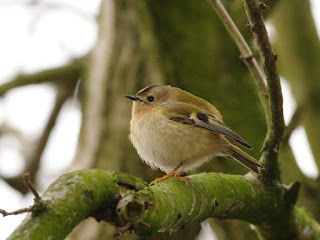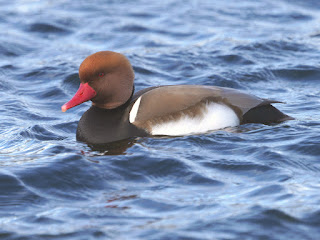There's another Long-Tailed Tits' nest under construction on the edge of the Long Water at the northwest corner of the bridge.
A Wren probed for insects in a tree near the Vista. I wonder what the thing in the centre of the picture is. It looks like a bunch of Harlequin Ladybirds.
A Great Spotted Woodpecker was drumming at the bottom of the leaf yard.
And anonymous photographer sent a picture of a Green Woodpecker on the north edge of Kensington Gardens, not a place where I've seen one but they move around a lot ...
... and also a fine shot of a Goldcrest.
The Redwings on the Parade Ground were poking about amid fallen twigs from the storm.
A Robin under a bench in the Rose Garden found a bit of tomato that had fallen out of someone's BLT sandwich. Most birds don't like salad vegetables, but the bright red often stirs their curiosity.
The Grey Herons' nest was swaying furiously in the wind and the chicks were keeping down out of the blast, but one of them looked over the edge for a moment.
A young Herring Gull dived repeatedly, trying to find food or a toy to play with.
Great Crested Grebes, with their large efficient feet, can cruise at considerable speed on the surface. (Under water they are even faster, exceeding 15 mph when hunting fish. I hope to get some footage of this later in the year when the light improves.)
A pair of Egyptian Geese enjoyed a wash and preen in the shallow water in front of Peter Pan.
The family on the south shore of the Serpentine have managed to keep their six goslings for another day, despite threats from gulls and crows. One thing in their favour is that there are very few Egyptians on this side of the lake. The greatest danger to the young arises when a pair have a territorial dispute and chase their rivals off, leaving the brood unprotected for crucial seconds.
Blondie, in her usual place near the Dell restaurant, strode across the muddy horse track which made a harmonious background for her colouring.
A single Red-Crested Pochard drake appeared first on the Long Water then on the Serpentine. We haven't seen one here for months, and they come and go at random.
When diving ducks dive, they make a little jump to help them to submerge.
It can be hard sometimes to tell a female Mallard (left) from a female Gadwall. When they raise their wings slightly to reveal their secondary feathers you can see that these are iridescent blue on a Mallard and white on a Gadwall. Gadwalls are slightly smaller and more delicate in build. When out of the water you can see that they are paler underneath, and have yellowish feet while Mallards have orange feet.













That's a great didactic picture putting mallard and gadwall females side by side. Great for learning the differences.
ReplyDeleteI suppose the Wren wasn't cacheing all those ladybirds, was it?
Did the Robin eat the tomato finally?
I'm not even sure that those are ladybirds. It might be some dried exudation of sap from the tree.
DeleteNo, the Robin quickly abandoned the tomato. But I have seen a Carrion Crow eat a large piece of tomato.
Agree it does look rather like a Harlequin & the sort of crevice one might over-winter in, though difficult to be 100% from this. I went on a tour of Margravine Cemetery last Saturday where we saw a small number of Harlequins & at least a couple of hundred Orange Ladybirds dormant on head stones & tree crevices.
ReplyDeleteLovely shot of the male Great Spotted Woodpecker & Goldcrest.
For those not too familiar with them a very instructive shot of female Mallard & Gadwall together. Good to see you have a Red-crested Pochard again.
That bit of Kensington Gardens is awash with Harlequins to the exclusion of all other kinds of ladybird, though I have found a few natives in other parts of the park.
DeleteIt's funny in that some years ago I was seeing Harlequins everywhere in numbers but in the last 3 or so years I've seen a fraction of the numbers I used to. Last Saturday when I was on a walk around Margravine Cemetery, led by Nathalie who monitors the hospital Peregrines, showed me some of the wintering ladybird aggregations there. There were a handful of Harlequins but we saw at least a couple of hundred Orange Ladybirds-she has counted over a thousand recently & in total about a dozen different species there. Orange Ladybirds feed on mildews growing on trees.
ReplyDeleteThe Wren must have seen the Harlequins but didn't stop to dig them out and eat them, and continued climbing the tree. Do they taste nasty?
DeleteYes ladybirds are quite foul-tasting. The bright colour of ladybirds warns that are bitter. Often if mis-handled they will exhibit a process called reflex bleeding & this contains some unpleasant chemicals.
ReplyDeleteThanks. I suspected as much. Seems to work for the dark morphs of Harlequins too.
Delete